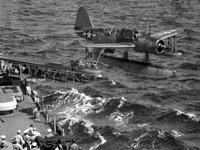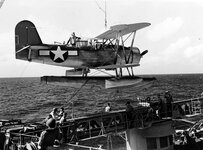Thread says it all. I don't need to explain why a floatplane is at disadvantage compared to a contemporary land based plane (or carrier based).
Yet every nation with interests on the sea toyed with the idea at some point. Only Japan fielded them in numbers during ww2 but I don't think the results were noteworthy: not even the mighty N1K 'Kyofu' could hope to best a contemporary US fighter, if not caught off guard).
The idea persisted well into the '50s with the remarkable Convair F2Y 'Sea Dart', which, at least, had the advantage of being supersonic and capable of using rockets and missiles
(when the engines worked: Westinghouse poor jet engines nearly ruined a generation of promising Navy fighters)
While being able to take off without a runway is certainly an advantage for any aircraft (STOL/VTOL planes have found their niche), when you know well in advance that your 'fighter' will be hopelessly under performing, why insist?
Yet every nation with interests on the sea toyed with the idea at some point. Only Japan fielded them in numbers during ww2 but I don't think the results were noteworthy: not even the mighty N1K 'Kyofu' could hope to best a contemporary US fighter, if not caught off guard).
The idea persisted well into the '50s with the remarkable Convair F2Y 'Sea Dart', which, at least, had the advantage of being supersonic and capable of using rockets and missiles
(when the engines worked: Westinghouse poor jet engines nearly ruined a generation of promising Navy fighters)
While being able to take off without a runway is certainly an advantage for any aircraft (STOL/VTOL planes have found their niche), when you know well in advance that your 'fighter' will be hopelessly under performing, why insist?


